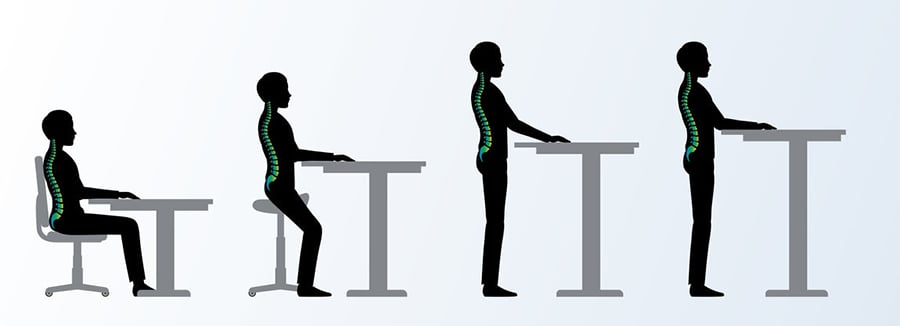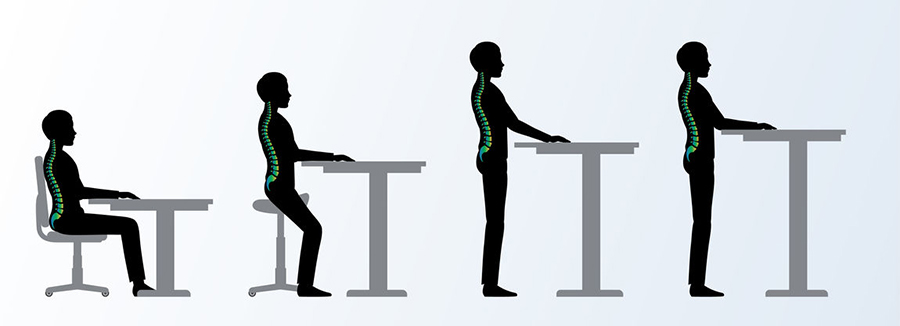
Many staff members at American College of Healthcare Sciences (ACHS), a holistic health and wellness college, are opting to use adjustable standing/sitting desks for health and vitality reasons and finding that it also helps keep their creative juices flowing. They did their research and are personally experiencing the nine health benefits of standing versus sitting. Check out what ACHS staff have to say about their experience using a standing desk:
- Obesity and Weight Gain
A recent study published by the Mayo Clinic reveals that standing for at least six hours throughout the day significantly decreases the probability of obesity in both men and women. The study used three measures to assess over 7,000 adults: body mass index, body fat percentage, and waist circumference. The researchers found that men who stood up for at least six hours per day had a 59% reduced likelihood of obesity. For women, standing for at least six hours a day was linked to a 35% reduced chance of obesity.
“I like moving around a lot, and standing keeps me more alert and engaged. I’ve been standing at work for six years now. I think that standing desk helps me manage my weight, stay focused on my work and have more purposeful interaction with my co-workers.”
Nathan Phillips, Chief Information Officer
- Standing vs. Sitting Lowers Risk of Heart Disease.
Choosing to stand rather than sit lowers blood sugar and cholesterol, and keeps weight off—all of which decreases the risk of heart disease. Researchers in Australia found that standing helps increase “good” HDL cholesterol and decrease “bad” LDL cholesterol levels. Trading standing for sitting for an extra two hours per day was associated with a 2% lower average fasting blood sugar level in both men and women, and an 11% lower average level of triglycerides. Simply substituting two hours of standing for sitting improved blood sugar and cholesterol levels.
“Standing at my desk helps me keep the creative juices flowing. I feel more alive and inspired while I’m working. When I sit for too long, I sink into the valley of fatigue. Standing means movement, air, circulation and the space for additional thinking and problem-solving. I’ve been standing at work for seven or eight years. I invested $15 to purchase a fatigue mat to help with the soreness that can develop in my calves, and I bought a foot roller to use when my feet get sore.”
Susan Marcus, Dean of Business
- Standing Helps Lower Risk of Type 2 Diabetes and other Metabolic Diseases.
According to the American Diabetes Association, breaking up your time of prolonged sitting by standing up on a regular basis, or even just walking for five minutes, can reduce blood sugar levels by 34%, especially in postmenopausal women. In this study, 22 overweight, dysglycemic, postmenopausal women either participated in prolonged, unbroken sitting for 7.5 hours, or prolonged sitting that was broken up with either standing or light-intensity walking. For the second day of the study, all participants underwent the 7.5-hour prolonged sitting protocol. Compared to only sitting, both standing and walking significantly reduced the average blood glucose levels and insulin levels in the women. The effects on glucose for the women standing and walking, and on insulin for those walking, continued into the following day.
“If I sit for too long, I get problems with my hips, Achilles tendon and back and standing helps with that. I’ve been using a standing desk for about five to six years. When I returned for a short time to sitting at my desk, I felt the issues returning,”
Tracy Reisinger, Director of Financial Aid
- Standing Lowers Long-Term Mortality Risk.
Research shows that not only can living a sedentary life lead to diabetes and heart disease it can also lead to death. One study even suggests that you can raise average life expectancy by two years by simply reducing your daily sitting time to three hours.
“I’ve been standing at my desk for more than four years. I remember when I used to sit in a chair at my desk. My back and legs would be stiff and need stretching when I stood up. Standing at my desk, switching to a vegan diet and exercise are a part of my ongoing health management plan. I’m simply more energized focused and on task throughout the day when I’m standing.”
Judy Starr, VP of External Relations
- Standing Helps Reduce the Risk of Cancer.
According to the American Institute for Cancer Research, almost 50,000 cases of breast cancer and over 40,000 cases of colon cancer each year are caused by inactivity.
Prolonged sitting, even by people who exercise on a regular basis, also increases the risk of cancer. Standing up throughout the day gets your circulation moving and reduces inflammation and other markers that raise cancer risk. Prolonged sitting is considered to be one of the largest cancer risk factors. Engaging in short bouts of activity such as standing and walking about can help protect against many cancers.
“Standing at my desk gives me a full range of motion. My job includes talking on the phone a lot, and standing allows me to engage my full body. I’ve been told that it makes me sound more confident when phoning students. I’ve been standing at work for one year and three months, and I actually began standing even before I got my standing desk.”
Michael Marney-Busstar, Admissions Assistant
- Standing Can Help Ease or Reduce Chronic Back Pain.
According to a Stanford University back pain study, workers who used sit-stand desks instead of regular desks while working were more likely to report a pain-free day. During this study, 46 participants received a sit-stand workstation either at the beginning or the end of the three-month trial. At the end of each workday, participants completed a short survey. Following weeks 1, 6, and 12, participants filled out comprehensive surveys. The surveys had a modified brief pain inventory and the Roland Morris Disability Questionnaire, which is designed to self-assess one's physical disability that is caused by low back pain. This study found that participants who were given a sit-stand workstation reported having a significant reduction in both their current and worst lower back pain over the three-month period.
My hips hurt if I sit too long and my doctor recommended I try a standing desk. I’ve been using it for about a month, and I do feel like it’s helping my issue.”
Jenn Morrison, Registrar
- Standing Helps Increase Energy Levels and Improve Mood.
Standing while working improves collaboration and encourages creativity. In fact, workers who use standing desks report less stress and fatigue than those who don’t. In a seven-week long study, 24 participants received sit-stand devices designed to fit their workstations, while others did not. Using experience-sampling methods to monitor sitting behavior helped the researchers estimate change scores in sitting time, health risk factors, mood, and other office behaviors on the basis of the survey responses. This project reduced the time that workers spent sitting by 224%, reduced upper back and neck pain by 54%, and improved people's moods. Additionally, once the device was removed, all of the observed improvements were negated within two weeks.
“I received my standing desk as a gift from my mother after she heard me complain about low energy at work in the afternoons. She stands 100% of her day at her work now and avoids sitting. I’ve started standing a few hours a day, and I already feel better. I’m just in my first month of using a standing desk.”
Andy Pierson, Website Coordinator and Graphic Designer
- Standing While Working Boosts Productivity.
In one study, call center agents who used a stand-capable desk over six months were found to be more productive than those who used regular desks. A comparison analysis was completed using a group of people using stand-capable desks and a group of people who remained seated throughout the day. The results showed that users of stand-capable desks were about 45% more productive each day compared to their seated colleagues. Additionally, the productivity of the stand-capable desk users significantly increased over time, from about 23% in the first month to about 53% over the next six months.
“Initially I started using a standing desk for health reasons and to improve posture. It’s harder to hunch over when you’re standing. Depending on what I’m working on, I get through tasks quicker because I’m in a more active stance. Initially, it was really important for me to be disciplined about it and set a schedule for standing until it became a habit. Comfortable shoes are a must. One of my New Year’s resolutions is to stand more. I’ve used a standing desk now for about a year, and I find that I feel more focused.”
Tracey Abell, Chief Operating Officer
- Standing While Working Helps Tone Muscles.
Standing while working helps strengthen your core muscles and leg, ankle, and foot muscles. It also helps improve your posture and balance. Standing with good posture is a great way to strengthen and tone your body. To ensure you have correct posture, stand up straight and center your feet below your hips. Tuck in your tailbone, push your shoulders back and straighten your neck so you are holding your head up high. This will help tone your core muscles, and can even raise your metabolism. With the one simple change of getting up throughout the day or doing as much of your work standing as possible, you can immensely benefit your health. Standing and walking throughout the day is an easy addition to your health regimen that won't cost you any time or money.
How to Easily Increase your Daily Standing
ACHS staff members who have made the shift to standing say they started by saying to themselves, “I need to stand more often”. The hard part is to actually go out and build the habits that will increase the amount of movement and standing. After a very short time, the benefits clearly outweighed any old habits. They report that they feel better, have less muscle and back pain, experience health benefits and have more energy. We’d love to hear from others who have made the switch from sitting to standing. You can email me at judystarr@achs.edu
About ACHS
Founded in 1978, ACHS.edu is a Portland, OR-based, accredited college offering online, on-campus, and study abroad integrative health education. ACHS also has a satellite campus in Kona, Hawaii. With undergraduate and graduate degrees, diplomas, certificates, and continuing education units in integrative health, ACHS makes holistic health and wellness education accessible to a diverse community, including healthcare professionals, military students, stay-at-home parents, and lifelong learners. Specializations include aromatherapy, herbal medicine, holistic nutrition, and wellness coaching. ACHS is a Certified B Corporation® and was ranked five of 100 Best Green Workplaces in Oregon 2018 by Oregon Business magazine. ACHS was also honored with 2016 and 2017 When Work Works awards, administered by the Families and Work Institute and the Society for Human Resource Management, and received the City of Portland Sustainability at Work Certification in 2017. ACHS is accredited by the Distance Education Accrediting Commission (DEAC), which is recognized by the U.S. Department of Education and by the Council for Higher Education Accreditation (CHEA), and is also approved by the Office of Degree Authorization of the Oregon Higher Education Coordinating Commission and authorized by the Hawaii Department of Commerce and Consumer Affairs, Hawaii Post-Secondary Education Authorization Program (HPEAP). Visit achs.edu.





